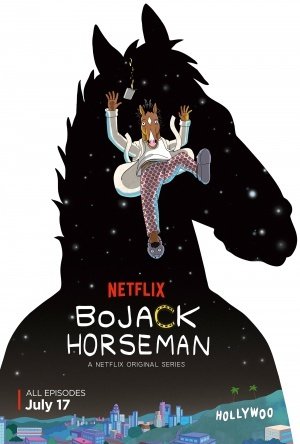What started life as a bizarre satirical take on Hollywood, with many prominent figures taking animal forms (Quentin Tarantulino for one), adapted, evolved and flourished as an emotional rollercoaster of a TV show that was, not only able to tell an engaging story whilst tackling the sides of mental health that others shy away from, but was able to do it brilliantly.
I was a bit late to the party for Bojack as I started watching after the third season was released, but thankfully that did give me ample opportunity to binge my way through it and get sucked into its bizarre world. The show revolves around the life of 90s sitcom star Bojack Horseman (Will Arnett), from his abusive childhood to late adulthood all whilst touching on themes of depression, addiction and accountability. From that premise spreads a world of ideas and situations that are on the one hand, too bizarre for live action, but on the other, just too real.
Attempting to define Bojack is tough, in season 1 it presents itself as a comedy, which predominantly derives from its alternate take on Hollywoo (where the D is stolen). But in later seasons, the show progressively lends itself into areas including fantasy, drama, tragedy and even musical to name a few. What’s more impressive is how this animated show manages to land each genre perfectly, adding layers of symbolism and hidden messages to keep audiences on their toes. However, its’ true achievement is in the characters. Not since Breaking Bad have I managed to generate significant emotional investment in an entire ensemble of characters. From the pushy, yet endearing Princess Carolyn (Amy Sedaris), to the shy, nerdy and heart-breaking Diane (Alison Brie) to even background characters such as the comedically perfect loose cannon that is Officer Meow Meow Fuzzyface.

My first realisation that Bojack was a different type of TV show arrived around the final two minutes of its’ eleventh episode (Downer Ending) where Bojack implores Diane to tell him that, underneath his selfish, narcissistic and destructive behaviours, he is a good person. That emotional gut-punch of a scene floored me. But that moment laid precedent for Bojack Horseman to place its mains in emotionally driven situations involving their past, their mental health and their fundamentally human flaws. This all adds to what makes the characters painfully identifiable. As a result, its eleventh episode would become the first of many to truly resonate with audiences on a level most other shows could only dream of attaining.
However, this type of storytelling can be made or broken by the writers. Thankfully, Raphael Bob-Waksberg knows exactly what he is doing. Whether it’s a 20-minute monologue channelling the emotions surrounding the death of a spiteful relative, a depiction of what happens in a person’s head or even when a character will administer a snappier tongue-twister that gets increasingly wittier, Bojack Horsemans’ writing never lets up. Paired with animators and a cast who collectively manage to portray every emotion felt in a situation to harrowing effect, then you have a show that can bring you from laughter to tears within mere scenes.
There is so much more to say about Bojack Horseman as it truly is a show for the ages. Thankfully, despite the final 16 episodes contending with two seasons worth of content, the closing two episodes manage to round this beautiful saga off on the perfect note. So, all that’s left to say is farewell and thank you to Bojack, Diane, Princess Carolyn, Todd and Mr Peanutbutter, you were all in a very special TV show.

